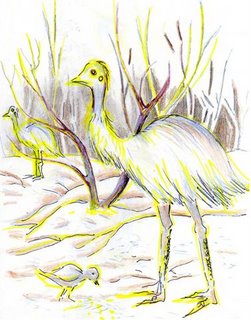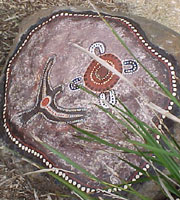The Narana Indigenous Garden
from Wendy
Last week I was at Narana and walked through the peaceful Curragundi (waterhole) indigenous garden and drew two of the emus there (behind a fence actually).

It is very dry at present and the waterhole half empty. The garden was reclaimed from 2 hectares of farmland in 1996 and is a testament to the recovering strength of nature. It includes a wide range of food source and medicinal plants, whilst surrounded by the aroma of native eucalypts. Kangaroo grass were collected by the women to be crushed into flour for making damper, which is a bush style bread cooked in hot coals. The Bottle Brush is a beautiful flowering trees. In the early morning the flowers were collected and soaked in water to make a sweetened drink; but you had to beat the birds to them. The River Red Gum was used in many ways. Canoes, shields, boomerangs and spears were made from the trunk and branches. A Hop Goodenia bush with leaves that were used as a pacifier for babies on long distance travelling. The leaves helped keep them calm whilst their mothers were collecting food, etc.
 Image left to right: exterior Narana Creations; ceiling of the Yingally Worark Gathering Place; rock paintings along the Yingally Wor-ark Tracks. Mural and Tracks created by Brian McKinnon, Cindy Alsop, Donna Goonan and Pat Tolputt.
Image left to right: exterior Narana Creations; ceiling of the Yingally Worark Gathering Place; rock paintings along the Yingally Wor-ark Tracks. Mural and Tracks created by Brian McKinnon, Cindy Alsop, Donna Goonan and Pat Tolputt.
 School children at Sacred Heart College in Geelong have developed an indigenous garden. Cindy Alsop, an artist fron Narana, has painted a Reconciliation Rock which is used to show the coming together of many different cultures both in Sacred Heart College and also in the wider community. The eagle on the Rock depicts the Great Spirit Bunjil, the Creator Ancestor of the Kulin Nation peoples of central Victoria, which includes our local Wathaurong area. The circle represents a campsite or meeting place and the "U" shape represents people.
School children at Sacred Heart College in Geelong have developed an indigenous garden. Cindy Alsop, an artist fron Narana, has painted a Reconciliation Rock which is used to show the coming together of many different cultures both in Sacred Heart College and also in the wider community. The eagle on the Rock depicts the Great Spirit Bunjil, the Creator Ancestor of the Kulin Nation peoples of central Victoria, which includes our local Wathaurong area. The circle represents a campsite or meeting place and the "U" shape represents people.
Last week I was at Narana and walked through the peaceful Curragundi (waterhole) indigenous garden and drew two of the emus there (behind a fence actually).

It is very dry at present and the waterhole half empty. The garden was reclaimed from 2 hectares of farmland in 1996 and is a testament to the recovering strength of nature. It includes a wide range of food source and medicinal plants, whilst surrounded by the aroma of native eucalypts. Kangaroo grass were collected by the women to be crushed into flour for making damper, which is a bush style bread cooked in hot coals. The Bottle Brush is a beautiful flowering trees. In the early morning the flowers were collected and soaked in water to make a sweetened drink; but you had to beat the birds to them. The River Red Gum was used in many ways. Canoes, shields, boomerangs and spears were made from the trunk and branches. A Hop Goodenia bush with leaves that were used as a pacifier for babies on long distance travelling. The leaves helped keep them calm whilst their mothers were collecting food, etc.
 Image left to right: exterior Narana Creations; ceiling of the Yingally Worark Gathering Place; rock paintings along the Yingally Wor-ark Tracks. Mural and Tracks created by Brian McKinnon, Cindy Alsop, Donna Goonan and Pat Tolputt.
Image left to right: exterior Narana Creations; ceiling of the Yingally Worark Gathering Place; rock paintings along the Yingally Wor-ark Tracks. Mural and Tracks created by Brian McKinnon, Cindy Alsop, Donna Goonan and Pat Tolputt.  School children at Sacred Heart College in Geelong have developed an indigenous garden. Cindy Alsop, an artist fron Narana, has painted a Reconciliation Rock which is used to show the coming together of many different cultures both in Sacred Heart College and also in the wider community. The eagle on the Rock depicts the Great Spirit Bunjil, the Creator Ancestor of the Kulin Nation peoples of central Victoria, which includes our local Wathaurong area. The circle represents a campsite or meeting place and the "U" shape represents people.
School children at Sacred Heart College in Geelong have developed an indigenous garden. Cindy Alsop, an artist fron Narana, has painted a Reconciliation Rock which is used to show the coming together of many different cultures both in Sacred Heart College and also in the wider community. The eagle on the Rock depicts the Great Spirit Bunjil, the Creator Ancestor of the Kulin Nation peoples of central Victoria, which includes our local Wathaurong area. The circle represents a campsite or meeting place and the "U" shape represents people.


4 Comments:
love your drawing. also love the painted rocks.
can't get over how long it's been since australia has gotten rain. for some reason, i thought it rained there more often... but since you're experiencing a drought, well, it makes sense.
Some people in the suburbs have indigenous gardens and their plants will survive, but too many of our plants and even grass species are not meant for low rainfall. In two weeks we go to Stage 4 restrictions - that means no water on the garden at all - only recycled water from our washing machines/bath tubs/kitchen sink. Yuck! We might have mutant flowers in the summer with all the detergent/shampoo, bubble bath products!
W.
These are interesting Wendy, If I ever get to Geelong again I must find these gardens. I like your drawings of them.
I'm really impressed. I wonder if anything like that has been done with any of the native tribes in the Americas...
Post a Comment
<< Home